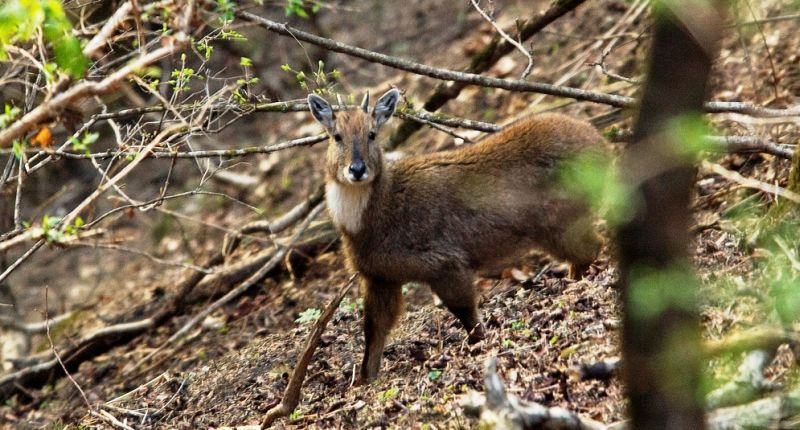
Nemorhaedus goral (Himalayan brown goral)
The Himalayan Brown Goral (Nemorhaedus goral) is a nimble, goat-like mammal native to the mountainous regions of the Himalayas, including the rugged slopes of the Great Himalayan National Park (GHNP). This elusive species plays a key role in the biodiversity of GHNP and is known for its excellent climbing skills and shy behavior.
Physical Features and Behavior
The Himalayan Brown Goral has a sturdy build, brownish-grey fur with a darker dorsal stripe, and short, backward-curving horns. Weighing around 35–40 kg, it blends seamlessly into its rocky environment, making it difficult to spot. These animals are typically crepuscular—most active during dawn and dusk—and are usually seen alone or in small groups.
Habitat in GHNP
In the Great Himalayan National Park, the Himalayan Brown Goral prefers steep, forested hillsides and rocky outcrops between 1,000 to 3,000 meters in elevation. These areas provide ideal cover and grazing opportunities, offering a mix of grasses, shrubs, and tree leaves. The park’s protected landscape helps shield this species from threats like poaching and habitat loss.
| Common name | Himalayan brown goral. |
| Latin name | Nemorhaedus goral Hardwicke 1825 |
| Local name | Ghoral. |
| IUCN/WPA/Indian status | Mujhathal WLS Himachal Pradesh |
| Social unit | Adult males are solitary but can associate with female groups especially for feeding |
| Size / weight | females form small groups of 2-3, very rarely 5-6 size. HBL: 82-120 cm. HAS: 60-70 cm. HL: 15-23 cm(male) Weight 35-42 kg (male). |
| Description | The brown goral is a small brown goat antelope. Shaggy, brownish grey in winter to a sleeker greyish brown in summer. I t has a white upper throat patch and white spots on its muzzle. Its horn are short, ridged and backward pointing, and thinner in females. A dark dorsal band extends to the tail. The under parts ate pale brown and the legs are bright brown with white flecking on the forelegs just above its black hooves. |
| Behavior | If alarmed , it stands its grounds, sneezing and hissing , and then bounds away in a zigzag course into scrub cover. |
| Distribution | Northern India, east of river Satluj along the Himalayas to Arunachal Pradesh, north ofg river Brahmaputra. |
| Habitat | Steep but grassy mountain slopes with low tree cover and moderate shrubs interspersed with cliffs .Avoids shrub growth above its shoulder height. Uses forest cover ., open gullies, cliffs and rocky areas for escape (400-4000 m). |
| Best seen | Mujhathal WLS Himachal Pradesh |
Ecological Role
As a primary herbivore, the Himalayan Brown Goral contributes to controlling vegetation growth and serves as prey for top predators such as leopards and wild dogs. Its presence indicates a healthy ecosystem and balanced food web, making it an important species for GHNP’s ecological monitoring.
Conservation and Importance
While currently classified as “Near Threatened” by the IUCN, the Himalayan Brown Goral faces pressures from deforestation and human encroachment. However, the sanctuary provided by GHNP plays a crucial role in preserving this species and maintaining the natural harmony of the region.
Conclusion
The Himalayan Brown Goral (Nemorhaedus goral) is a key mountain species whose survival depends on the conservation efforts inside areas like the Great Himalayan National Park. Their presence is a testament to the park’s commitment to protecting Himalayan wildlife and ensuring a thriving, biodiverse landscape for future generations.



